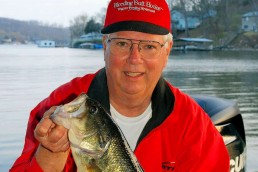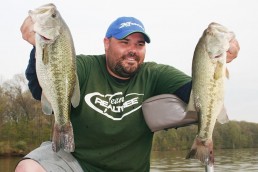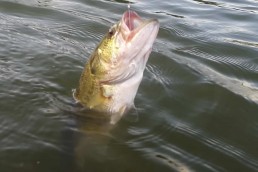‘Twilight Zone’ Bassin’
SHARE THIS POST
It’s a magical time—not quite day or night, but a period of transition. The sun sinks out of sight, the light slowly fades and the wind dies. Crickets, frogs and whippoorwills wail; an owl hoots and insects hatch. Catfish move toward the shallows and big bass prowl.
I’ve always loved this time of the evening for its mood, so I always stayed out because I’m not afraid of the dark and learned a long time ago that bats won’t get tangled in my hair like momma claimed.
The period is called “twilight,” and I’m often reminded of the Rod Serling TV series, The Twilight Zone. A lot of weird stuff happened in the show, but in the real world it is the “fishing zone,” and that is equally enchanting to me.
Most fishermen miss all this—they head to the dock before sunset or as the sun is setting and are on dry land by the time the “twilight zone” (fishing zone) “airs” across the broad screen of our major impoundments. They really don’t know what they’re missing.
From staying out while everyone else heads for the house like good little boys afraid of bats, I found that this half hour or so of the “twilight zone” contains some of the best fishing of the entire day.
Then the frantic feeding shuts off like a light switch.
The twilight zone is so good because of the way a fish’s eyes work; they function differently from ours.
For one thing, their eyes are placed on the sides of their heads, affording them monocular vision, which means they can see well on both sides of their heads at the same time. Their only blind spot is a narrow area directly behind them where its body obstructs its vision. We, on the other hand, have binocular vision, which keeps our field of view to the front, but also allows us a “depth-of-field” perception.
Are you enjoying this post?
You can be among the first to get the latest info on where to go, what to use and how to use it!
Like some of us, fish are nearsighted, which means that unless a lure makes noise or omits a scent trail, it needs to be cast closely to the fish to be detected. They do also have a limited binocular vision similar to ours in a narrow band directly in front of them. Their binocular vision, however, is really just an overlapping of their monocular vision. Although they can see things at a little greater distance, these objects are blurred and depth perception is impaired, sort of the way we see if we cross our eyes slightly.
Scientists say bass receive about five times more light through their eyes than humans. This, of course, gives them better vision in deep or dark areas, but it doesn’t mean that they can see five times better than humans per se. It means, simply, that they are five times more sensitive to light. They need this extra sensitivity because water absorbs light quickly. The deeper or more turbid the water, the less light there is to reflect off objects. Plus, when the surface is broken by ripples some of the light is refracted so the diffusion of light is rapid.
But fish have a fixed lens and the cornea is of uniform thickness, so they can’t blink and they don’t have eyelids or pupils to dilate and compensate. They do compensate by seeking shade or moving deeper when the light is bright. Often, the shade of a laydown fallen tree are enough to block strong rays.
The biggest difference—and the reason they become so active during the twilight zone—is they have two types of receptor cells in the retina. Their “cone” cells perceive color and are used mostly during the day, while their “rod” cells see only in black and white and are used at night.
This rod-cell dominance gives them excellent night vision. This is why, as most night fishermen know, black is the best color to fish at this time as it provides the most contrast in a black and white world. It’s also the best color to use during the twilight zone because by this time bass are ramping up their night vision. These receptor cells reverse themselves every 24-hour period, but it is a slow process. An hour or two before sunset, internal senses trigger the advance of black-and-white vision in preparation for darkness. Completion of this process takes hours, so it is believed they have a sort of “color-fade” as their night vision rod cells advance, but it also means they become even more sensitive to light. It is similar to how our eyes adjust when coming from a darkened theater into bright sunlight. It can even hurt for a few seconds, but in a few seconds our pupils dilate and adjust to the light. Fish require three to five hours to accomplish a similar adjustment.
At a certain point of fading light, however, bass gain a visual advantage over their prey because they already have a jumpstart on their night vision. This causes a brief but intense feeding spree—this is that magical twilight zone.
At a certain time twilight evolves into actual darkness, and all, or nearly all, feeding ceases. I’ve often continued fishing well into the darkness and through the night; rarely have the first couple hours of darkness been productive. That’s partially because the fish’s night vision isn’t fully installed and partially because they feed so heavily during the twilight zone that they aren’t especially hungry. In a couple hours or so they can see nearly as well as during the day and their guts begin to grumble.
Night fishing has always been best after midnight for me. But my favorite of all is that special period of daily transition, when it is neither day nor night—the twilight zone.
MWO
SHARE THIS POST
Did you enjoy this post?
You can be among the first to get the latest info on where to go, what to use and how to use it!
Ron Kruger
Ron Kruger has been communicating the outdoor experience for more than four decades. He has worked as a full-time guide for trout on the North Fork, for crappies and bass on Kentucky Lake and for smallmouths on the Current River. He has served as editor of three outdoor magazines, and owns a patent on a fly/lure called the Desperate Diver.



